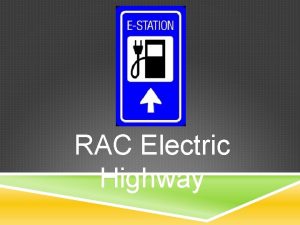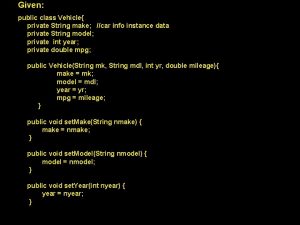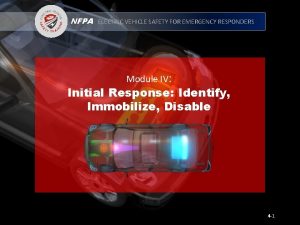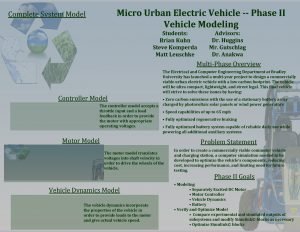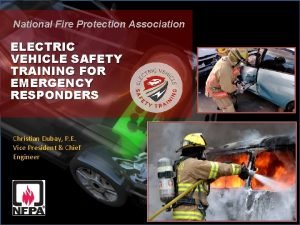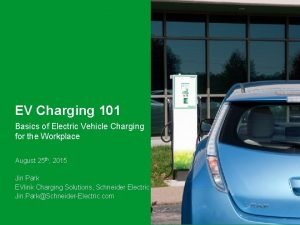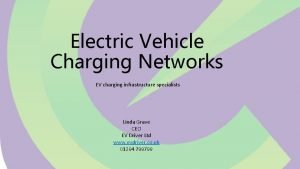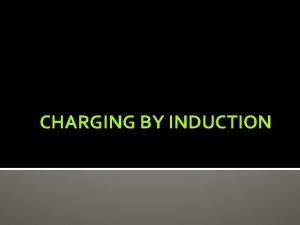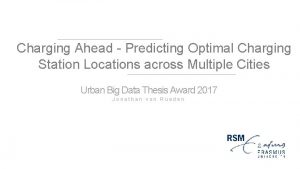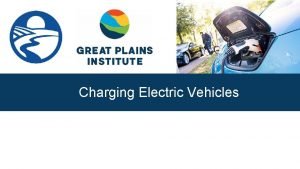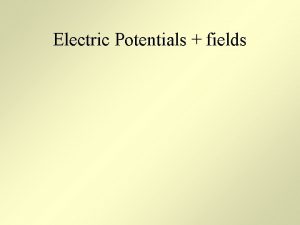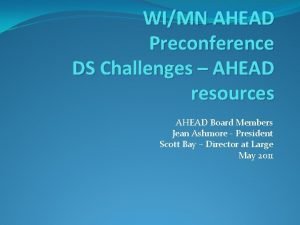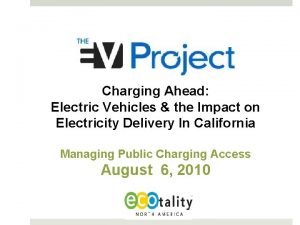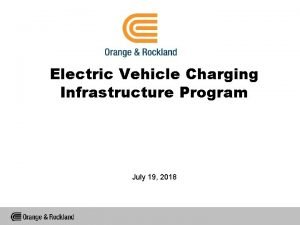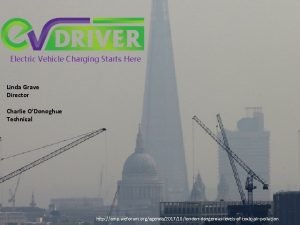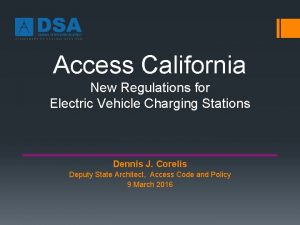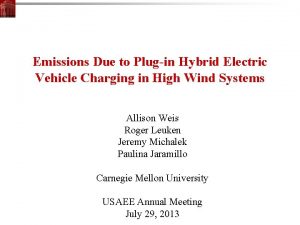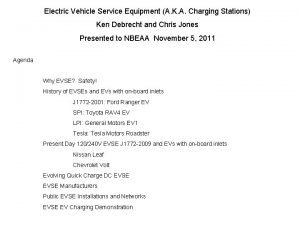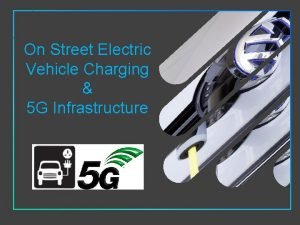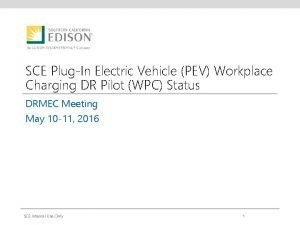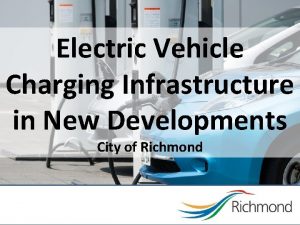Cities Charging Ahead Electric Vehicle Informational Presentation Overview



















- Slides: 19

Cities Charging Ahead! Electric Vehicle Informational Presentation

Overview of Cities Charging Ahead! Led by the Great Plains Institute (GPI) and Clean Energy Resource Teams (CERTs), Cities Charging Ahead! is a peer cohort of 28 cities working together across Minnesota exploring electric vehicle readiness. Participating cities receive technical assistance focused on actions and best practices, based on the Green. Step Cities program, that cities can implement to accelerate the adoption of electric vehicles such as: • Including electric vehicles in city purchasing plans • Installing electric charging infrastructure in public parking areas • Providing guidance on electric vehicle - ready development in the private sector

Funding for CCA Funding is provided through the Carolyn Foundation, Energy Foundation, and in partnership with Xcel Energy, which provides resources in line with the company’s long-term clean energy plan to electrify transportation.

Participating Cities Albert Lea Fond Du Lac Richfield Bloomington Fridley Rochester Burnsville Grand Marais St. Louis Park Coon Rapids Hackensack Virginia Duluth Hastings Warren Eagan Inver Grove Heights White Bear Lake Edina Maplewood Winona Elk River Marine on St. Croix Woodbury Falcon Heights Morris Faribault Red Wing

Green. Step Cities Best Practices • Minnesota Green. Step Cities is a voluntary challenge, assistance, and recognition program to help cities achieve their sustainability and quality-of -life goals. • Based on 29 best practices. • Several are EV focused

EV-Focused Practices 2. 3 Implement an energy rating/disclosure policy for residential and/or commercial buildings. • Renewable Energy Ready Home Specifications • Zero Energy Ready Home Specifications Example Require energy use disclosure for certain commercial buildings, using Hennepin County's tools for cities in Minnesota; require landlords to disclose the energy usage for residential rental properties; require residential energy disclosure at time-of-sale; report both Energy Efficiency rating and Renewable Energy Ready Home (includes EVready elements) site assessment results or certification. Report city policies that incentivize acting on commercial building ratings - recommissioning and retrofitting - under action 2. 6

EV-Focused Practices 3. 4 Provide a financial or other incentive to private parties who build new buildings that utilize the SB 2030 energy standard and/or a green building framework. • Going beyond incentives, cities may require all new residential homes and public parking facilities to accommodate EVs. Example Incentives require meeting the SB 2030 energy standard, or require buildings to be rated/certified under a green building framework. Features might include conduit for EV chargers in new home garages; incentives might include a density bonus.

EV-Focused Practices 6. 5 Adopt climate mitigation and/or energy independence goals and objectives in the comprehensive plan or in a separate policy document, and include direct implementation recommendations such as becoming an EV-ready city.

EV-Focused Practices 8. 3 Modify a planned unit development ordinance to emphasize mixed use development or to limit residential PUDs to areas adjacent to commercial development. Example Ordinance: requires a mix of uses; requires installation of EV charging stations

EV-Focused Practices 9. 1 Establish design goals for at least one highway/auto-oriented corridor/cluster. Example Work with community members in establishing design goals or design standards, publish the standards, and ensure that the standards are providing to everyone proposing development in the corridor/cluster; plan for at least 1 EV charging station.

EV-Focused Practices 9. 5 Adopt development policies for large format developments, such as a scorecard approval process, tax productivity thresholds, size caps, bans, required decommissioning of vacant property. Example Adopt a size cap; require decommissioning in the zoning district or with the development agreement for chain-specific big box developments, if store goes vacant for more than 6 months; plan for at least 1 EV charging station.

EV-Focused Practices 11. 1 Adopt a complete streets policy that also addresses street trees and stormwater. Example A city council resolution to develop standards; a policy governing city-owned streets; routine consideration of complete streets elements in all streets projects; explicit complete streets comp/strategic plan direction, that expresses the city's intent to facilitate multi-modal transportation (at least one route for each mode); include consideration of EV charging stations.

EV-Focused Practices 11. 3 Modify a street in compliance with the city's complete streets policy. Example Summarize the complete streets elements – grey infrastructure such as adding sidewalks, bump outs, bike lanes, truck routes, broad band, EV charging station, smart grid.

EV-Focused Practices 13. 2 Right-size/down-size the city fleet with the most fuel-efficient vehicles that are of an optimal size and capacity for their intended functions. • The alternative vehicle decision tool from MN Extension and the U. S. Dept. Of Energy's Alternative Fuels and Advanced Vehicles Data Center both have cost calculators and other tools. Note however that lithium-ion batteries represent a huge environmental footprint in their manufacture and reuse/recycling them isn't addressed in the Extension tool.

EV-Focused Practices 13. 3 Phase-in no-idling practices, operational and fuel changes, and equipment changes including electric vehicles, for city or local transit fleets. Examples • Monitor fuel usage and costs on a regular basis; report data to fleet managers and users; implement maintenance schedules that optimize vehicle life and fuel efficiency; replace solvent-based vehicle parts washing with aqueous-based; adopt a no-idling policy/practice or conduct training for more efficient driving • Achieve a 1 -star rating and add a highway-capable full-electric vehicle, and/or install a solar-charging EV station. Report EV charging stations that the public can use under best practice action 23. 5.

EV-Focused Practices 18. 7 Document that the operation and maintenance, or construction/remodeling, of at least one park building used an asset management tool, the SB 2030 energy standard, or a green building framework. Example Include green features in at least one park building, such as renewable energy generation capacity, EV charging station, native landscaping, rain gardens, green roofs, composting toilets, and greywater systems.

EV-Focused Practices 23. 5 Install, assist with, and promote one or more public fueling stations for plug-in hybrid and full electric vehicles, flex-fuel ethanol vehicles, CNG vehicles. Examples • Work with others to place 1 station at a high use area; promote the existence of all fueling options such as compressed natural gas in/around the city. • 2 or more geographically separated EV charging stations, or a level 3 DCFC station, or 1+ EV stations powered by non-grid renewable energy. • Report the installation of 4+ stations; connect at least 1 station to on-site renewable generation such as PV panels.

EV-Focused Practices 25. 6 Promote green businesses that are recognized under a local, regional, or national program. Example Recognize and promote (on your city website) businesses whose environmental actions are recognized by a local, regional, or statewide program, such actions as recycling, reducing materials use, lowered toxicity in products, selling locally created compost, energy efficiency, EV charging station for employees/patrons, etc. . .

Thank You! Diana Mc. Keown Metro. CERT Director dmckeown@gpisd. net 612 -278 -7158 Kris Acuña Project Assistant kacuna@gpisd. net 612 -400 -6291
 Santa clara fleet management electric vehicle charging
Santa clara fleet management electric vehicle charging Rac electric highway
Rac electric highway Public class vehicle private string name
Public class vehicle private string name Nfpa electric vehicle emergency field guide
Nfpa electric vehicle emergency field guide San joaquin valley drive clean! rebate program
San joaquin valley drive clean! rebate program Electric vehicle controller
Electric vehicle controller Denver electric vehicle council
Denver electric vehicle council Electric vehicle emergency field guide
Electric vehicle emergency field guide Smart cities presentation
Smart cities presentation Business intelligence overview presentation
Business intelligence overview presentation Electric field equation
Electric field equation Potential energy due to point charge
Potential energy due to point charge Electric potential vs electric potential energy
Electric potential vs electric potential energy Electric field and electric potential
Electric field and electric potential A suitable electric pump in an electric circuit is a
A suitable electric pump in an electric circuit is a Chapter 21 electric charge and electric field
Chapter 21 electric charge and electric field Chapter 21 electric charge and electric field
Chapter 21 electric charge and electric field Unit of charge
Unit of charge Dc o/d per item charge
Dc o/d per item charge Electric charges and electric forces lesson outline
Electric charges and electric forces lesson outline

